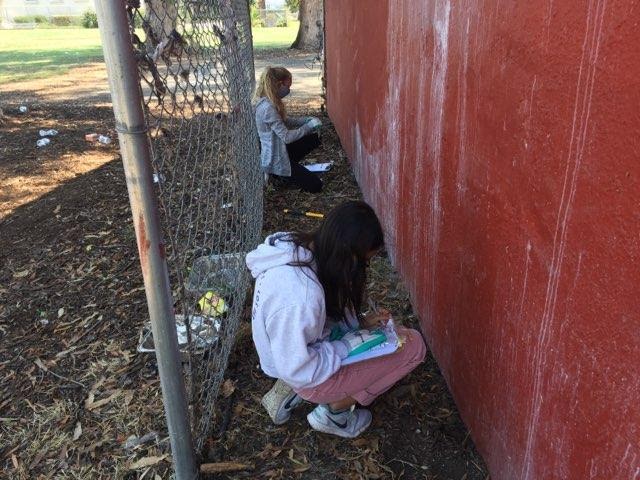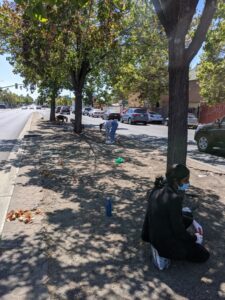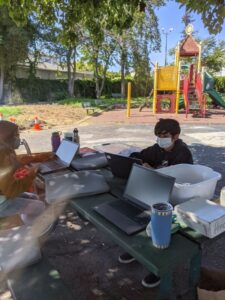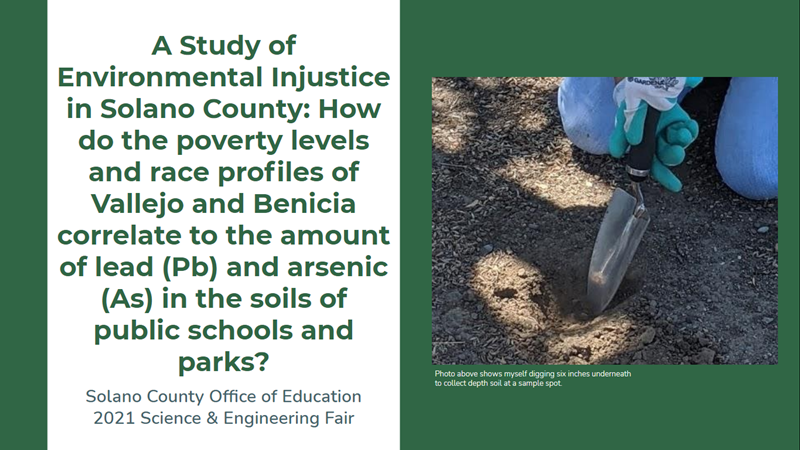By Allison McCabe
Allison McCabe is a rising Benicia High School junior and passionate about environmental science. She won this year’s Solano County Science and Engineering Fair with her research on toxins found in soil samples in Benicia and Vallejo — research she undertook to examine environmental justice issues in Solano County. We are excited to be working with her to shape Sustainable Solano’s environmental justice fellowship in Benicia for the coming school year.

Allison McCabe and another Lawrence Hall of Science intern taking soil samples at Allendale Park in east Oakland
I stared at the X-ray fluorescence analyzer in shock to see the soil sample I had just collected at Nicol Park in east Oakland read over 700 parts per million of lead on the device, almost nine times the California Environmental Protection Agency standards. This discovery would lead me to think upon what this data meant for the east Oakland community, which was disproportionately affected by such toxins, and set me on a path to study environmental injustice there and here in Solano County.
Last summer I received the opportunity to intern at the UC Berkeley Lawrence Hall of Science through a program called the East Bay Academy for Young Scientists. I got to spend two months of my summer in east Oakland, investigating soil and air pollution with nine other Bay Area high schoolers with the guidance of three adult mentors from the Lawrence Hall of Science: Colleen Sutherland, Eric Campos and Kevin Cuff. Our team collected and analyzed over 500 air samples and 600 soil samples throughout the two-month period. I learned a wide range of skills and the program gave me insight on what it is like to be an environmental scientist. I got to use scientific equipment such as air beam monitors and soil pollution analyzers. I even learned how to statistically analyze large data sets and how to write a scientific abstract.
However, the most important takeaway from the program was the chance to address environmental injustice in the Bay Area. In particular, I looked at lead and arsenic contaminants in the soil, two toxic metals that bring devastating effects to the human body, including slowed growth and development, learning and behavior problems, and hearing and speech problems. My research found that soil samples collected in low-income and communities of color typically had higher amounts of pollution in the soil compared to higher income communities. This is because historically marginalized communities are more likely to be exposed to landfills, toxic waste, highways, and other environmental hazards. Factors such as old lead water pipes, paint mixed with lead, and factories that dealt with recycled lead batteries most likely contributed to the amount of lead in the soil I detected.

Lawrence Hall of Science interns collect soil samples at Verdese Carter Park in east Oakland

Allison McCabe and another intern record soil sample results onto a Google spreadsheet
I initially applied to the program to learn more on environmental science, sustainability, and climate change but by the time I finished my experience, I learned about the intersection between environmentalism and social justice. The interconnection between the two was so intriguing to me as it was something I never learned about before. I’ve always been passionate toward environmental issues such as climate change, but I never understood that historically marginalized people are disproportionately affected by it. I realized that combating climate change is vital to mitigate its disportionate effects on people of color and other marginalized communities.
After the program finished in August 2020, I had the opportunity to present my findings in the program at the American Geophysical Union Conference (AGU) through the Bright STaRs program. After the conference, I felt inspired to continue to investigate and learn more on the issue of environmental injustice even though my internship had come to an end.
Within those few months, my fascination for environmental justice grew immensely. I joined the Solano Youth Coalition’s Social Justice and Racial Equity Committee to continue my work in environmental justice. At the moment we are working on a podcast series, “Teens Talk Social Justice” where I hope to share my personal experiences and thoughts on environmental injustice.

Additionally, I have brought my experiences from east Oakland to Solano County. From October 2020 to March 2021 I worked on a project for the Solano County Science and Engineering Fair, “How do the poverty levels and race profiles of Benicia and Vallejo correlate to the amount of soil in public schools and parks?” (See the slide presentation here) I collected over 150 soil samples in the cities of Vallejo and Benicia for lead and arsenic. My research found alarmingly high levels of lead in the soil of public schools and parks in Vallejo. My goal is to collaborate with the Vallejo school district to replace the soil at parks and schools that exceeded standards to address environmental injustice in my community to ensure that everyone, no matter their race or income, does not have to face the burden of soil pollution and its effects.
Also, I have been working with Sustainable Solano to create an environmental justice fellowship program for Benicia high school students. I am extremely excited to launch the program in the fall with Sustainable Solano. It has been an amazing experience getting to shape the fellowship program. I have been brainstorming presentation ideas, interactive workshops, service opportunities, and the curriculum. I want to make the issue of environmental injustice known, and by helping to create the program, I get to bring my experiences from east Oakland to Benicia. In the fellowship, I hope to share my involvement collecting air and soil quality data in east Oakland and hopefully give the opportunity for the fellows to do the same in their communities.
In a few months I will be continuing my pathway in the field of environmental science. This summer I have the opportunity to intern and work under the direction of Dr. Pedro Monarrez and Professor Jonathan Payne to understand the evolution of biodiversity and body size as a Stanford Earth Young Investigator with 13 other Bay Area high school students. I am extremely excited to examine life during the Cambrian and Ordovician periods while getting to present at the AGU for a second time in a row. Last year the conference was virtual, however I am hoping that the meeting will be in-person this year so I get the chance to meet space and earth scientists from all over the world.
After looking back on my involvement in the environmental justice movement this past year, I now know that I want a career in the environmental field. I realized that it is essential for me as a future environmental scientist to look at the environment from a social justice perspective, and to make sure I am advocating for a world in which race and class do not determine the environmental quality of a community or the health of those living in it. I want to be a part of the solution, dedicating my life to work towards environmental justice and a sustainable planet for all.

